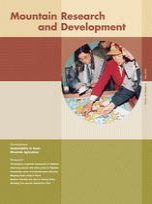This workshop took place at the Centre for Development Studies (21–22 November 2003), and was co-hosted by the University of Bergen and the Chr. Michelsen Institute. Fragility is closely linked to the livelihood risks faced by people living in the Himalayan region. They live precariously on scattered, scarce resources that are insufficient or periodically unavailable due to disasters. There is now a consensus that human impacts on the environment are more complex and contingent than assumed earlier. Still, a central tenet of mainstream research is premised on the fragility of the Himalayan environment and, by implication, the mountain dwellers who depend on it for their livelihoods. The overall aim of the workshop was to elucidate how well the “fragility narrative” characterizes historical and contemporary ecological and social processes as well as man–nature interactions in the Himalayas. Could it be that mountain environments are less “fragile” and more resilient than often presumed?
The workshop participants represented many different disciplines, such as geography, glaciology, ecology, anthropology, and political science. Martin Price gave a keynote introduction on how the fragility concept is used in different ways in mountain environments around the globe. The other keynote speaker, Jack Ives, presented a précis of his forthcoming book, which aims to revisit the critique of the crisis scenario documented in the landmark book The Himalayan Dilemma, published in 1988. Ives has collected additional empirical support for his claim that it is not the poor mid-hill agropastoralist that is the main agent behind the “catastrophic cascade:” overpopulation in the mid-hill areas, deforestation, increased agriculture, soil erosion, and consequently catastrophic flooding in the lowlands.
The theme of climate change was dealt with from various angles. It was demonstrated that land use change from forest to agriculture would increase emissions of gases that affect the climate, especially methane. Global warming is considered the prime cause of the alarming retreat of Himalayan glaciers. However, complex deglaciation models, simulating glacier retreat and increased runoff, do not support claims that all glaciers will disappear within this century. Instead, the model predicts that heterogeneous topography will cause significant differences in the pace of retreat. A local case study showed that small glaciers might disappear within this century, whereas larger glaciers with a substantial proportion of ice above 5500 m will probably not disappear in the foreseeable future. It was also pointed out that most of the dramatic data on glacier retreat in the Himalayas are measured in meters per year, which says nothing about the actual volume of ice being lost.
A second workshop theme was deforestation. According to Ives' new book, both reforestation and deforestation occur in various parts of the Himalayas. Hence it is very difficult to be certain whether there is an overall decrease in average forest cover. However, deforestation is a serious problem in the West Himalayas (Pakistan), where it is closely associated with accessibility and the construction of new roads. The synthesis of ecological and socioeconomic interrelationships illustrates that the synergistic effects of socioeconomic factors and the available resource potential always govern the extent of forest degradation. For instance, it was shown that unresolved ownership and boundary disputes reduce commercial timber logging and cause logging operations to fall behind schedule. Consequently, the rate of deforestation is considerably lower in valleys where communal ownership of forests survives and hence is contested, than in valleys where ownership is privatized by influential villagers or by the state's forest department.
A third issue was soil erosion. A study in the Middle Hills of Nepal found that unmanaged forests with free grazing had more than twice the soil loss of managed forests without free grazing. However, annual soil loss from any grazing land is also much higher than from agricultural land, eg maize, millet, or irrigated rice fields. Although soil erosion is not mainly caused by agriculture, rapid soil redistribution may hinder the build-up of an A-horizon rich in nutrients and micronutrients. A natural zinc deficiency is a major problem in Himalayan agriculture, which causes zinc deficiency in the diet and increases susceptibility to diarrhea and other diseases.
The biodiversity issue was also elucidated. It is now a demonstrated fact that in the Nepalese Himalayas maximum plant diversity is at medium elevation (1500–2500 m). Diversity decreases towards the alpine zones and is lowest in the intensely cultivated subtropical lowlands. However, the moderately disturbed mid-hill forests, often found at the periphery of the cultural landscapes, may have more plant diversity than undisturbed or degraded forest. Thus it is important to preserve the cultural landscape and integrate conservation of biological and cultural diversity with traditional local knowledge.
In the trans-Himalayan region, major interventions aim at developing pastoral animal husbandry, which may affect productivity and species diversity. In general, the traditional grazing system makes use of high mobility to adapt to the non-equilibrium dynamics of grasslands. By contrast, the grassland regulation law allocates grasslands to the individual household and promotes sedentary animal husbandry, a form of utilization that is based on the traditional equilibrium grassland paradigm. The predicted results of the interventions vary according to the assumptions of ecosystem fragility or the robustness of the degree to which equilibrium or non-equilibrium conditions prevail.
This multidisciplinary workshop was not able to conclude whether the Himalayan environment is more resilient than fragile. Nevertheless, all disciplines indicated the enormous variety of the different key variables such as forest cover, soil erosion, biodiversity, and glacier retreat. Thus it is a paradox that the inherent human and environmental variability in the Himalayas makes the mountain system resilient at broad spatio-temporal scales, but at a given time and place it appears fragile due to the numerous localized catastrophic events associated with steep mountain environments.





